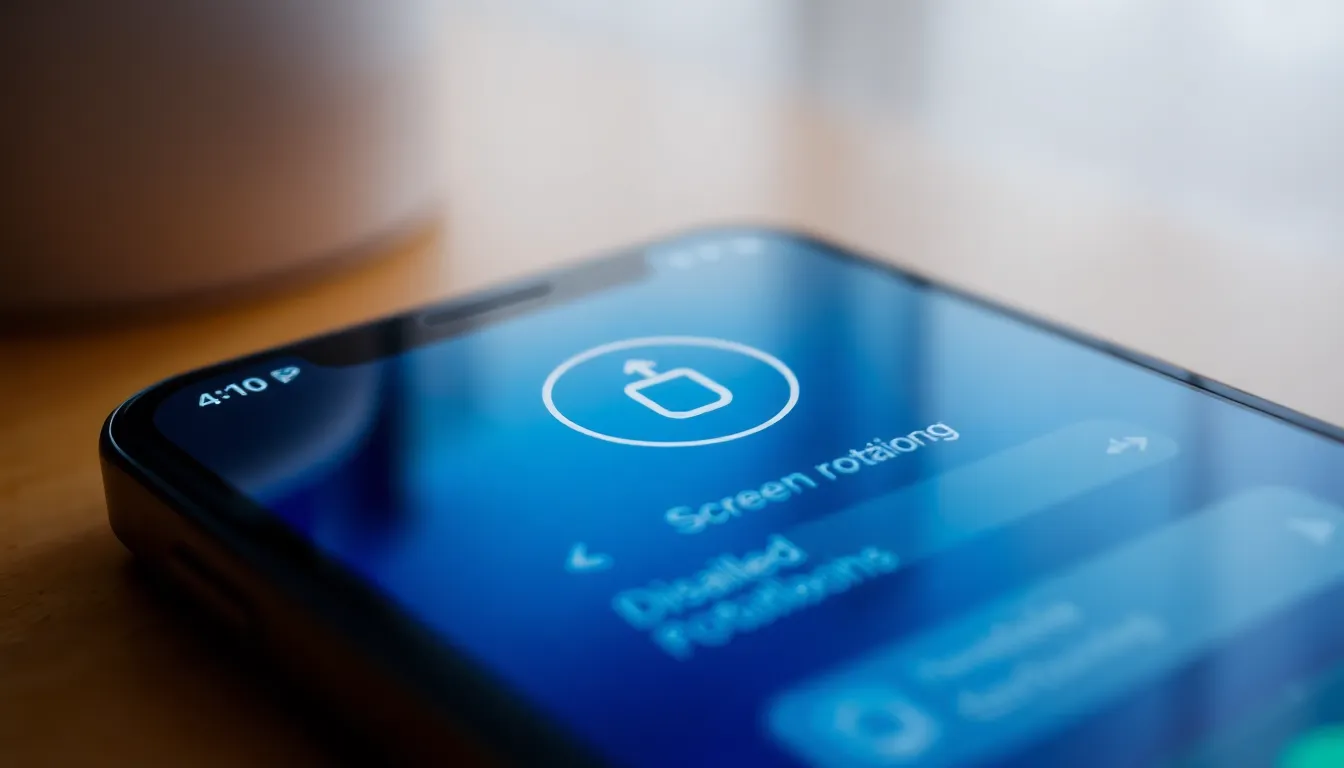Table of Contents
ToggleEver found yourself in a battle with your iPhone screen, desperately trying to get it to rotate while your friends snicker in the background? Don’t worry, you’re not alone. Many users face this quirky little challenge that can turn a simple task into an Olympic event. Whether you’re trying to watch a video or read an article, a stubborn screen can be more annoying than a mosquito at a barbecue.
Understanding Screen Rotation
Screen rotation allows an iPhone’s display to shift between portrait and landscape orientations. This feature adjusts the layout based on how the device is held, enhancing the user experience.
What Is Screen Rotation?
Screen rotation refers to the automatic adjustment of a device’s display orientation. When an iPhone is turned, sensors detect the angle and trigger changes in the interface. Most applications support this function, providing a better view tailored to the content displayed.
Benefits of Screen Rotation
Screen rotation improves usability in various scenarios. Users benefit from a more extensive view when watching videos or viewing photos. Navigating websites becomes more intuitive as landscape mode offers additional space for content. Overall, this feature enhances accessibility, adapting the screen to the task at hand.
Common Reasons for Rotation Issues

Rotation issues on iPhones often stem from a few common causes. Understanding these reasons can help users quickly fix the problem and restore functionality.
Disabled Rotation
Disabled rotation settings frequently cause screen orientation issues. Users can inadvertently toggle this option on and off. To check the setting, users should swipe down from the top-right corner to access the Control Center. Look for the lock icon with a circular arrow; if it’s highlighted, rotation is disabled. Tapping the icon enables screen rotation again. In addition, some apps may have their own rotation settings that can override the general setting.
Software Bugs
Software bugs sometimes lead to unexpected rotation failures. Users may experience this after updating their iOS or installing new apps. Restarting the iPhone can resolve temporary glitches that hinder rotation. If problems persist, users might consider updating to the latest iOS version, as updates often fix known bugs. Alternatively, resetting settings can restore screen orientation functionality without losing personal data.
How to Enable Screen Rotation
Ensuring screen rotation works properly involves a few simple steps. Users often start by checking key settings that control this feature.
Checking Control Center Settings
Opening the Control Center remains the first step. Users swipe down from the top-right corner on iPhones with Face ID or swipe up from the bottom on older models. The screen orientation lock icon appears as a padlock surrounded by an arrow. Tapping this icon toggles rotation on or off. If the icon appears highlighted, the rotation feature is disabled. Users will need to tap again to enable rotation. After this, they should test the screen orientation by tilting the phone.
Adjusting Display Settings
Adjusting display settings may also help resolve rotation issues. Users should access Settings, followed by Display & Brightness. Here, they can confirm that Display Zoom is set to standard, which supports screen rotation. If they notice the settings indicate Zoomed, switching back to Standard enables full functionality. Ensuring that Night Shift mode isn’t affecting rotation is also crucial. Some apps might restrict rotation based on specific settings. Verifying that apps in use allow rotation allows users to maximize their experience.
Troubleshooting Screen Rotation Problems
Screen rotation issues can frustrate iPhone users, but several strategies can help resolve these problems.
Restarting Your iPhone
Restarting an iPhone often resolves minor glitches. To do this, press and hold the side button and either volume button until the slide to power off option appears. Users can then slide to power off, wait a few moments, and press the side button again to turn the device back on. A fresh start can clear temporary software quirks that impact screen rotation. After restarting, users should test whether rotation functionality has been restored.
Updating iOS
Keeping iOS updated plays a crucial role in maintaining device performance. Users can check for updates by navigating to Settings, then tapping General, followed by Software Update. If an update is available, users should proceed to download and install it. Updates often include fixes for bugs that may affect screen orientation, reinforcing device stability. After the update process, it’s wise to test screen rotation across various apps to ensure it’s functioning correctly.
Alternative Solutions
Users can explore alternative methods to address screen rotation issues when standard troubleshooting steps don’t resolve the problem.
Using Third-Party Apps
Some third-party apps offer enhanced screen rotation capabilities. Apps like “Rotation Control” enable users to manage orientation settings more precisely. These applications provide options to override default system settings and can be particularly helpful for users experiencing persistent rotation issues. Easy access to rotation controls remains a key feature, allowing customization based on individual preferences. Users should read reviews and research compatibility before downloading any app, ensuring it meets their unique needs.
Seeking Apple Support
When difficulties persist despite trying various solutions, contacting Apple Support proves beneficial. Apple’s support team can assist with advanced troubleshooting methods specific to each device model. Users can reach out via the Apple Support app or visit the official website for assistance options. Scheduling an appointment at a local Apple Store or service provider offers a hands-on approach to resolving technical difficulties. Clear explanations of the problem will help ensure a swift resolution by trained professionals.
Getting an iPhone screen to rotate smoothly can significantly enhance the user experience. By understanding the common issues that prevent rotation and knowing how to troubleshoot them effectively, users can quickly resolve frustrations. Whether it’s adjusting settings in the Control Center or ensuring the latest software updates are installed, these steps empower users to regain control over their device’s functionality. For persistent problems, exploring third-party apps or seeking assistance from Apple Support can provide additional solutions. With these strategies in hand, users can enjoy a seamless experience when using their iPhones in any orientation.





